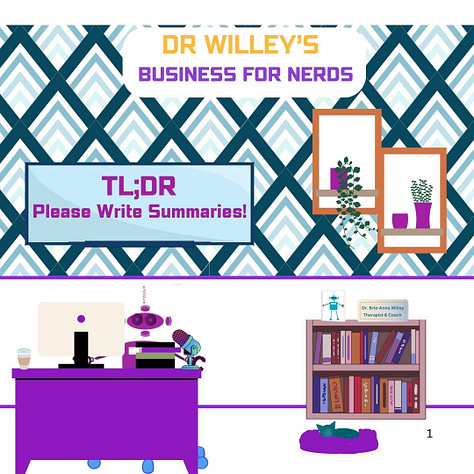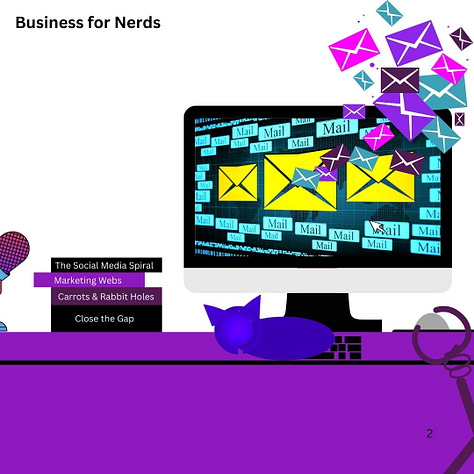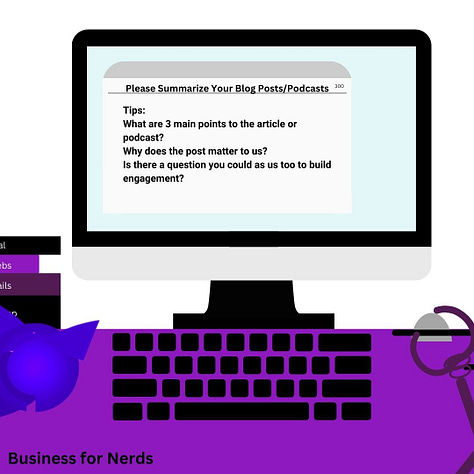TLDR & Why Note Summaries Are Invaluable
Summary notes help us understand what you're writing
Hello! This is a new section of my blog called the Social Media Spiral, please subscribe if you want to hear more.
TL;DR: Why Your Posts Need TL;DRs
Okay okay. So I have made fun of the trend of Substackers writing posts about how to Substack… on Substack.
And now here I am doing the very same thing.
But hear me out.
This isn’t just about Substack; It’s about making your work more accessible across the internet: Facebook, Instagram, BlueSky, LinkedIn, Reddit, YouTube, Pinterest… anywhere you share content.



The Real Talk on TL;DRs
“TL;DR” means Too Long; Didn’t Read.
As an older millennial, I didn’t even know this term until I stumbled into the joy-chaos that is Reddit. But it clicked instantly. And if you're anything like me (juggling coaching, therapy, blogging, podcasting, life), you probably skim more than you read. Your audience is doing the same.
So let’s help them.
Why Note Summaries Are Gold 💡
Whether you’re writing a newsletter, sharing a podcast, or publishing a long social media caption, a summary helps your readers decide if your content is for them.
Not everyone has the time or energy to read the full post. But if they catch your TL;DR and feel seen? They’ll scroll back up and read.
It’s not about oversimplifying your work. It’s about building a bridge.
TL;DR Writing Tips for Therapists, Coaches, & Creators
📌 Summarize your content clearly1 – Write 2–5 bullet points or a short paragraph.
📌 Use emojis or formatting – They help break up text and draw the eye.
📌 State why it matters – Help the reader understand the takeaway.
📌 Ask a question at the end – It invites interaction (and algorithms love that).
📌 Turn it into a meme – Yes, really. A summary meme is a power tool.
Example: Here's a TL;DR for this Post*
✨ TL;DR: Summaries help busy readers understand your content and decide to engage.
Use bullet points, emojis, and key takeaways.
Ask a question to spark conversation.
Bonus: Make a meme about it.
Your audience will thank you.
🧠 Questions: Do you already write TL;DRs? When you read other people’s summaries, what makes you want to click “read more”?
*Watch me use this or something similar in notes and across my social media platforms.
The Bottom Line
Please stop saying “Check out my post!”
Instead, show them why they should care. TL;DRs are a kindness, a strategy, and a connection-builder. And if you’re a therapist, coach, or creative (especially one navigating compassion fatigue or content burnout) this is a small step that makes a big difference.
What’s your experience with all the blogs you subscribe to?
Do you enjoy having a little summary? For especially long posts, would a TL;DR at the beginning help you dive in more easily?
Thanks for reading — and stay nerdy!
– Dr. Brie
P.S. I’m reorganizing the Nerdiverse! I just launched a new section called the Social Media Spiral, and this post is officially published under that category. The Nerdiverse is coming together, one galaxy at a time! 🚀🌀
P.P.S. I just updated the the Realm of Private Practice too — go take a peek if you’re a therapist in the nerdiverse. 🌌



So true Brie. With so many things to read these days I need some way to weed out the ones I want to spend time on. I think of tl;dr like the back of a book - if I'm not intrigued by the synopsis I'm probably not going to read it. - Katherine
I actually really like this advice!!! Finally something useful about writing on substack! Haha